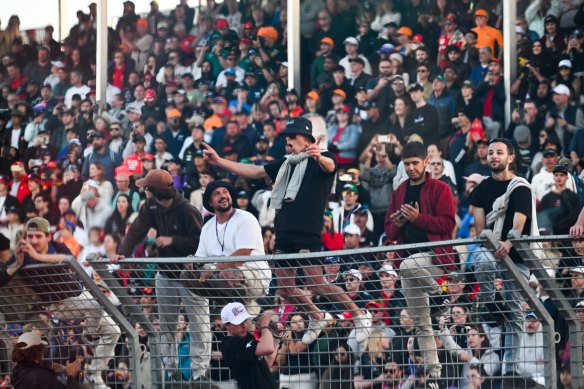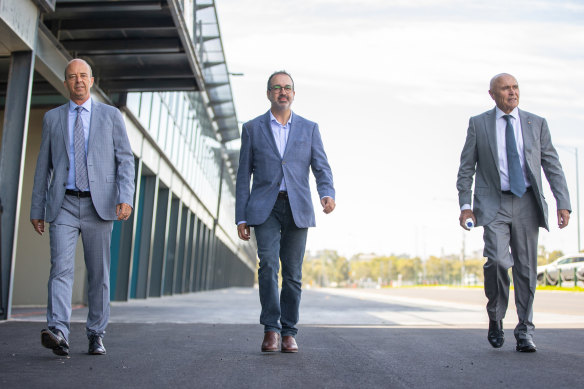Cost of hosting this year’s F1 grand prix hits record $100m
Save articles for later
Add articles to your saved list and come back to them any time.
Victorian taxpayers have been left with a record bill from this year’s Formula 1 grand prix, with runaway costs associated with the race outpacing revenue generated by record attendances across a bumper four-day event.
The annual report of the Australian Grand Prix Corporation, tabled in state parliament on Thursday, reveals the government-controlled body spent $198 million to stage this year’s race at Albert Park. This represents an increase of $44 million, or 29 per cent, from 2022, and a whopping 72 per cent increase from two races ago.
The cost of this to taxpayers is $100.6 million, up from $78 million in 2022.
This year’s Australian Grand Prix attracted recorded attendances.Credit: Joe Armao
This masthead previously revealed that part of the reason for the increased cost was an undisclosed, additional licensing fee former premier Daniel Andrews and former sports minister Martin Pakula last year agreed to pay to the global owners of F1, Liberty Media, for the rights to this year’s race, despite having previously secured them in 2019.
Pakula was last month appointed chairman of the Australian Grand Prix Corporation. He replaced businessman Paul Little, who was sidelined from last year’s contract negotiations when Andrews, alarmed by the discovery of an advanced bid by NSW to steal the event, stepped in to deal directly with F1 boss Stefano Domenicali.
The Victorian government agreed to a 12-year contract extension with Liberty Media to keep the race until 2037. This included renegotiated terms for the rights it already held to promote the Australian Grand Prix between 2023 and 2025.
Although the terms of the licensing fee paid to F1 are tightly held by both parties, the fee for this year’s race is accounted for under a $119 million event management and staging expense contained within the AGPC annual report.
The cost to taxpayers of this year’s race will place pressure on the Victorian government to explain its unorthodox contract negotiations and what it is being done to put the brakes on expenditure associated with the event.
“Jacinta Allan needs to explain how the costs of the event have escalated so rapidly and what she is going to do to protect taxpayers from further cost blow-outs,” Opposition sport and events spokesman Sam Groth said.
“It also raises more questions about Labor’s handling of contract negotiations for major events, as we saw with the Commonwealth Games debacle.”
Tourism, Sport and Major Events Minister Steve Dimopoulos did not answer questions from this masthead about the contract negotiations, the fee paid to F1 or whether the government was seeking to reduce grand prix costs.
Dimopoulos emphasised the broader benefit of the Australian Grand Prix which, according to an Ernst & Young report commissioned by the government, pumped $144 million directly into the state’s visitor economy.
“From driving tourism and investment attraction, to contributing to the vibrancy and livability of our state, to creating more jobs, hosting the Formula 1 Australian Grand Prix provides so many proven economic benefits to Victoria,” he said.
“This iconic event generated an estimated $266 million for Victoria, with more than 444,000 fans taking to the course over the four days – boosting businesses, local jobs and our unrivalled hotel and hospitality sector.”
Former sport minister Martin Pakula (centre) replaced Paul Little (right) as AGPC chairman, with Andrew Westacott (left) resigning as chief executive. Credit: Simon Schluter
The mass appeal of Formula 1, underpinned by the success of Netflix’s Drive to Survive series, was reflected in the 444,631 people who pushed through the Albert Park turnstiles. That generated $76 million in ticket sales and a record $96 million in total revenue. Both of these figures were significantly up from 2022.
The flip side is that high inflation, a post-pandemic labour shortage, soaring freight costs and the addition of Formula 2 and Formula 3 racing to the Albert Park program added to the cost of assembling and dismantling the temporary street circuit and stands and running the event. The AGPC also increased its headcount from 77 staff to 92 and its wages bill by $6.7 million.
The largest line-item increase in expenses was for event management and staging, which jumped from $80 million to $119 million. This figure includes the undisclosed fee paid to Liberty Media.
Since the 2023 race came to its chaotic, stop-start finish, with local driver Oscar Piastri securing the first championship points of his F1 career, Little and fellow AGPC directors Tal Karp and Kate Lundy have stepped down from the board. Andrew Westacott resigned as chief executive after 12 years in the job.
Pakula and the AGPC’s new chief executive Travis Auld, along with Little and Westcacott, are all in the US for this weekend’s first running of the Las Vegas Grand Prix. That event, which is wholly owned and promoted by Liberty Media, will be staged at an estimated cost of more than $US400 million ($617 million).
Start the day with a summary of the day’s most important and interesting stories, analysis and insights. Sign up for our Morning Edition newsletter.
Most Viewed in Politics
From our partners
Source: Read Full Article

